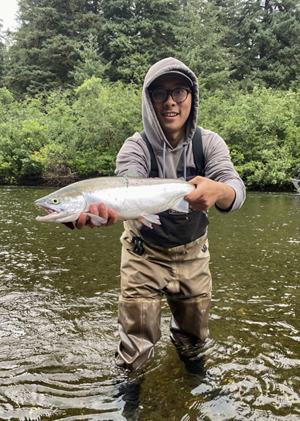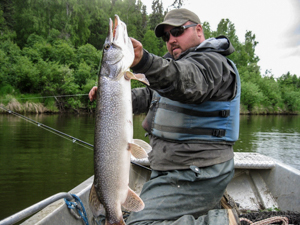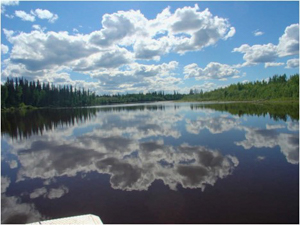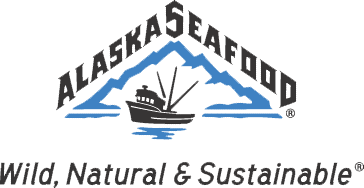
June 2023
Issue 66
Freezer-Filling Fun – Make the Most of This Fishing Season
 June is the month when many anglers take to the water to begin the process of filling their freezers with fresh salmon fillets. There are many opportunities for anglers across the state to head out in pursuit of fresh fish.
June is the month when many anglers take to the water to begin the process of filling their freezers with fresh salmon fillets. There are many opportunities for anglers across the state to head out in pursuit of fresh fish.
In this edition of Reel Times, we share some great content aimed at helping you put some fish up this season. But before you head out, be sure you have your 2023 sport fishing license. Visit our online store if you need to purchase one. Or download the ADF&G mobile app and you can store your licenses, tags, and permits on your mobile device.
Are you following us on social media? If not, be sure to check us out on Instagram @wefishak. You can also follow us on Facebook at ADF&G - wefishak . Also, visit our YouTube channel for a growing selection of "how-to" videos and much more.
If you have a comment or story ideas for Reel Times, we encourage you to send them our way. You can send comments to ryan.ragan@alaska.gov.
We'll see you on the water
Situk River – Southeast Alaska’s Sockeye Destination
By, Jason Pawluk (Yakutat Area Management Biologist – Division of Sport Fish)
 Southeast Alaska (SEAK) has a lot to offer in terms of sport fishing opportunities. Both salt and fresh waters provide a plethora of piscatorial pursuits to engage in. Halibut, lingcod, rockfish, black cod, shrimp, crab, and all five species of salmon should keep you pretty busy on the Saltchuck. While inland on the freshwater streams and lakes, steelhead, cutthroat, rainbows, Dolly Varden, coho salmon, pink salmon, and chum salmon are readily available in most locations. But having moved to SEAK from Southcentral AK where I grew up, my first question when I got here was, “where do you go to get your reds?”
Southeast Alaska (SEAK) has a lot to offer in terms of sport fishing opportunities. Both salt and fresh waters provide a plethora of piscatorial pursuits to engage in. Halibut, lingcod, rockfish, black cod, shrimp, crab, and all five species of salmon should keep you pretty busy on the Saltchuck. While inland on the freshwater streams and lakes, steelhead, cutthroat, rainbows, Dolly Varden, coho salmon, pink salmon, and chum salmon are readily available in most locations. But having moved to SEAK from Southcentral AK where I grew up, my first question when I got here was, “where do you go to get your reds?”
Growing up along the banks of the Kenai River I found out I might have been spoiled when it comes to the relative ease and bounty of sockeye salmon available to a sport angler. I was quickly told that sockeye aren’t as abundant in SEAK and given the lack of road systems connecting the areas of SEAK, the few streams that have sockeye are difficult to get to. But, if you are willing to spring for a plane ticket to Yakutat, then you may have solved where to sport fish for sockeye in SEAK.
Yakutat is home to the world-famous (and Alaska famous) Situk River. And the Situk River provides something that the rest of SEAK does not…an easily accessible sport fishing destination for sockeye salmon. For the past 10 years, the Situk River has accounted for approximately 80% of all sockeye harvested in SEAK freshwater sport fisheries.
 Alaska Airlines has daily jet-service into Yakutat twice a day, and couple that with the abundance of rental vehicles, accessing this famous stream is pretty easy for a few bucks. From Yakutat, the distance to the two main access locations is only 9-13 miles. Lodging might be an issue, but there are a lot of options in town, and at the very least there are some places to camp along the river, roads, or nearby. But let’s talk about the sockeye or “reds.”
Alaska Airlines has daily jet-service into Yakutat twice a day, and couple that with the abundance of rental vehicles, accessing this famous stream is pretty easy for a few bucks. From Yakutat, the distance to the two main access locations is only 9-13 miles. Lodging might be an issue, but there are a lot of options in town, and at the very least there are some places to camp along the river, roads, or nearby. But let’s talk about the sockeye or “reds.”
For the past two years, the Situk has seen runs of sockeye past the weir in excess of 90k fish. And for a relatively small river, 90k fish makes it seem full of those tasty sockeye salmon. Since 2009, the Situk River has exceeded the upper end of the escapement goal (30,000 – 70,000 fish) nine times! Only once (2018) during that time did the lower end of the escapement goal fail to be achieved. Since 1988 the Situk River on average puts 69k sockeye past the weir. And that doesn’t even include the roughly 5-10k sockeye harvested downstream of the weir each year. So what does all this mean? It means that there are a lot of sockeye available on the Situk River for sport anglers compared to the rest of SEAK.
When does all this take place you might ask? Right now. At the time of this writing (June 7th) sockeye are already entering the Situk and passing the weir in good numbers for this early in the run. That portends to a good run given similar historical weir counts by this date. The peak of the run typically occurs from mid-June to late-July. When the department projects that the run could exceed the upper end of the escapement goal, the daily bag and possession limit is increased to 6 fish per day. That has happened 9 times since 2009, and early indications are looking good.
 What do I use to catch these sockeye in a stream so small? Good question. The key is using lighter gear, especially when the sockeye are holding in slower moving and deeper water. I see a lot of anglers using bare Gamakatsu hooks (sizes 2 – 2/0) or with a little bit of orange yarn in the snell-knot with about a 4-5 foot long leader. For weight, splitshot is used, but not too much! Try starting with a couple of BB split shot and add more if needed. Unlike large glacial rivers like the Kenai, the gear used on the Situk is not weighted down as much and the goal isn’t necessarily to be bouncing along the bottom. Sometimes small corkies are pegged in the middle of the long leader to keep the hook off the bottom and in the “fishy zone.” These Situk reds tend to hold off the bottom, so more weight just gets you below the “fishy zone” and most likely leads to the fish getting snagged on the hooks’ way down to the bottom. Anglers also use small “flashy” flies like a polar shrimp or crystal-meth pattern. By flipping these set-ups upstream of the group of fish and letting it drift downstream into them, it increases the chance the fish will strike, or your line will “floss” right through their mouths leading to a legal hook-up.
What do I use to catch these sockeye in a stream so small? Good question. The key is using lighter gear, especially when the sockeye are holding in slower moving and deeper water. I see a lot of anglers using bare Gamakatsu hooks (sizes 2 – 2/0) or with a little bit of orange yarn in the snell-knot with about a 4-5 foot long leader. For weight, splitshot is used, but not too much! Try starting with a couple of BB split shot and add more if needed. Unlike large glacial rivers like the Kenai, the gear used on the Situk is not weighted down as much and the goal isn’t necessarily to be bouncing along the bottom. Sometimes small corkies are pegged in the middle of the long leader to keep the hook off the bottom and in the “fishy zone.” These Situk reds tend to hold off the bottom, so more weight just gets you below the “fishy zone” and most likely leads to the fish getting snagged on the hooks’ way down to the bottom. Anglers also use small “flashy” flies like a polar shrimp or crystal-meth pattern. By flipping these set-ups upstream of the group of fish and letting it drift downstream into them, it increases the chance the fish will strike, or your line will “floss” right through their mouths leading to a legal hook-up.
Remember that any snagged fish must be released. A snagged fish is any fish hooked anywhere other than inside the mouth.
The main access points on the Situk are at the Lower Landing boat launch and the 9-mile bridge. There are angler trails at both locations that can get you to many different fishing spots along the river. If you are willing to walk a little, you can get away from other anglers and access areas where you can likely fish in solitude. Sockeye basically stack up in any deeper hole or run so they are basically everywhere along the river this time of year. Good luck and happy fishing!!
The Hoholitna River: A hidden gem on the Middle Kuskokwim River
By John Chythlook Area Management Biologist, Kuskokwim River Drainage
Description
 Ever thought of fishing a little-traveled river in the middle Kuskokwim River Drainage? If so, a trip on the Hoholitna River should near the top of your list.
Ever thought of fishing a little-traveled river in the middle Kuskokwim River Drainage? If so, a trip on the Hoholitna River should near the top of your list.
The Hoholitna River is a tannic, clearwater river that flows 165 miles north from its headwaters in Whitefish Lake in the Nushagak Hills to eventually join the lower Holitna River. There is excellent fishing for Dolly Varden and Arctic grayling, as well as large, voracious northern pike in the lower river and sloughs all summer long. King and chum salmon are available late-June and July while coho salmon are present during late August and September. Anglers normally access the lower Hoholitna by chartered boat from the village of Sleetmute. The Hoholitna River is also navigable by prop boat for much of the lower 20 river miles. The river is all Class I, but there are sweepers and log jams which require some boating skill to avoid.
Tackle
 All the species present are attracted to egg patterns, especially during salmon spawning. Silver and flashy streamers work well below water, and dry flies can be productive during the right conditions. Silver/pink or orange spoons and silver or gold spinners work well for spinning gear, as well as white, pink, and silver jigs. Pike will hit surface lures such as mouse or frog patterns and are attracted to large rubber fish lures as well. Always use steel leaders for pike fishing. Sheefish are often not too picky, but when they are a large, light-colored spoon or a duck-billed diving lure can be just the ticket.
All the species present are attracted to egg patterns, especially during salmon spawning. Silver and flashy streamers work well below water, and dry flies can be productive during the right conditions. Silver/pink or orange spoons and silver or gold spinners work well for spinning gear, as well as white, pink, and silver jigs. Pike will hit surface lures such as mouse or frog patterns and are attracted to large rubber fish lures as well. Always use steel leaders for pike fishing. Sheefish are often not too picky, but when they are a large, light-colored spoon or a duck-billed diving lure can be just the ticket.
Getting There
Access to the Hoholitna River is normally by float plane charter, either through McGrath, Aniak, Bethel, or by charter from Anchorage. There is also scheduled air service to Sleetmute. The river is normally floated, where there are providers of both guided and unguided trips. Outfitted trips are available that include raft or other equipment rental and aircraft charter. There are also some small but comfortable lodges on the river. The float normally takes about 10 days. Bears are common along the river, and floaters should take appropriate cautions.
Species
Dates
Begin: May 15
Ends: September 15
Regulations
Before you go fishing, please check the regulations.
Fishing at John Hedberg Lake on the Kenai Peninsula
By Jenny Gates
 Local lakes are open and fishable on the Kenai Peninsula, and the Alaska Department of Fish and Game would like to let you know about a fishing opportunity in Northern Kenai! John Hedberg Lake (located in North Kenai at Mile 23.25 Kenai Spur Hwy) was added to the lake stocking program for the Kenai Peninsula and stocked with catchable sized rainbow trout in the fall of 2021.
Local lakes are open and fishable on the Kenai Peninsula, and the Alaska Department of Fish and Game would like to let you know about a fishing opportunity in Northern Kenai! John Hedberg Lake (located in North Kenai at Mile 23.25 Kenai Spur Hwy) was added to the lake stocking program for the Kenai Peninsula and stocked with catchable sized rainbow trout in the fall of 2021.
The Nikiski Community Council approached the department with a request to stock John Hedberg Lake in late 2020. One of the considerations for stocking a lake is legal public access. Typically, stocked lakes are located on public lands managed by the state, federal government, or local municipality. Although John Hedberg Lake is located on privately managed land, the 113-acre parcel surrounding John Hedberg Lake was developed into Nikiski Community Park for public use with restrooms, a year-round trail network for skiing, biking, and hiking, parking areas and community garden.
 After evaluating the public access, the department conducted two lake evaluations (winter and summer) to assess whether a viable fish population could be sustained. Having concluded the lake had adequate depth and dissolved oxygen, no native fish species, ideal habitat and sources of food, the department worked with the council to draft a 10-year cooperative agreement where the department will stock John Hedberg Lake and the council will provide and maintain public access for sport anglers. Other terms agreed upon include no hunting or motorized vehicles and quiet hours are between 10:00 pm and 8:00 am. Lakeside picnic tables and benches are also present for anglers to relax and enjoy the mixed forest scenery while watching and listening to loons. This peaceful, road-accessible lake will be annually stocked with 1,000 catchable sized rainbow trout. We hope to see you out there!
After evaluating the public access, the department conducted two lake evaluations (winter and summer) to assess whether a viable fish population could be sustained. Having concluded the lake had adequate depth and dissolved oxygen, no native fish species, ideal habitat and sources of food, the department worked with the council to draft a 10-year cooperative agreement where the department will stock John Hedberg Lake and the council will provide and maintain public access for sport anglers. Other terms agreed upon include no hunting or motorized vehicles and quiet hours are between 10:00 pm and 8:00 am. Lakeside picnic tables and benches are also present for anglers to relax and enjoy the mixed forest scenery while watching and listening to loons. This peaceful, road-accessible lake will be annually stocked with 1,000 catchable sized rainbow trout. We hope to see you out there!
The sockeye are in!
 June is a great month to get out and target sockeye. Sockeye, also known as “Red” salmon are fun to fish for and are prized by many anglers for their excellent table fare. There are many rivers in Alaska that offer exceptional sockeye fishing opportunities.
June is a great month to get out and target sockeye. Sockeye, also known as “Red” salmon are fun to fish for and are prized by many anglers for their excellent table fare. There are many rivers in Alaska that offer exceptional sockeye fishing opportunities.
Here are a few resources to help you bring more of this tasty fish to the grill.
- How to Fish for Klutina River Red Salmon
- Sockeye Salmon Fishing 101
- How to Tie a Shrimp Fly for Sockeye
- Sockeye Salmon Species Profile
Good Luck!
Field to Plate - Recipe of the Month
Recipe of the Month – Wild Alaska Sockeye Salmon Burger with Florida Grapefruit and Tarragon Burger Sauce
 Here’s a delicious recipe for Wild Alaska Sockeye Salmon Burger with Florida Grapefruit and Tarragon Burger Sauce from the Alaska Seafood Marketing Institute.
Here’s a delicious recipe for Wild Alaska Sockeye Salmon Burger with Florida Grapefruit and Tarragon Burger Sauce from the Alaska Seafood Marketing Institute.
Enjoy!
If you have any questions about the Reel Times newsletter, please contact Ryan Ragan at ryan.ragan@alaska.gov
